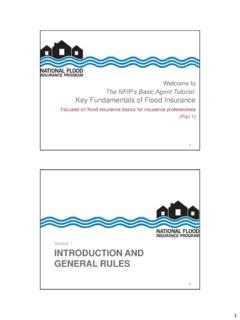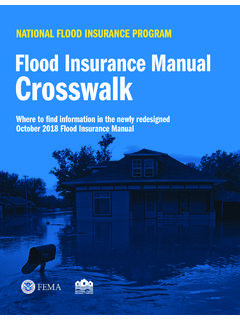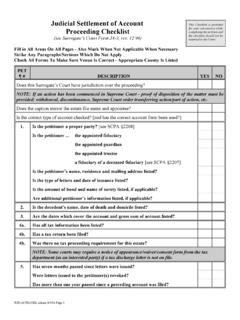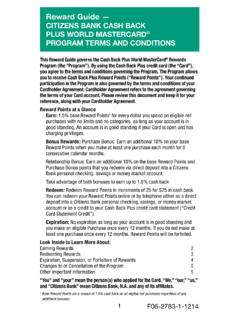Transcription of Special Flood Hazards; Interagency Questions and …
1 Department of Homeland Security 500 C Street, SW Washington, DC 20472 W-08021 April 16, 2008 MEMORANDUM TO: FROM: Federal Insurance Administrator National Flood Insurance Program SUBJECT: Procedures Relating to Flood Zone Discrepancies The Federal regulatory agencies supervising federally regulated lending institutions must require their lenders to take certain actions to ensure buildings in high-risk areas known as Special Flood Hazard Areas (SFHAs), the areas subject to inundation by the base (1-percent-annual-chance) Flood , are properly protected, and Flood insurance is retained for the life of those loans. These requirements are explained in the attached Federal Deposit Insurance Corporation Financial Institution Letter dated December 21, 2007, and the draft revisions to the document entitled Loans in Areas Having Special Flood Hazards; Interagency Questions and Answers, which is available online from the website Lenders obtain Flood zone determinations for the buildings for which they make loans or hold mortgages.
2 Flood zone determination companies report to lenders the Flood zone information for the building based on the current Flood Insurance Rate Map for each community. When the Flood insurance policy declarations page for the building shows a Flood zone other than the one reported on the Standard Flood Hazard Determination Form, lenders are concerned that the policy may be incorrectly rated. The Department of Homeland Security, Federal Emergency Management Agency (FEMA), understands Flood zone discrepancies are occurring because some WYO companies are no longer accepting the Flood zone determinations provided by lenders to rate Flood policies. WYO companies are either providing their own Flood zone determinations or requiring agents to determine the Flood zone. As a result, lenders are frequently finding the Flood zone indicated on a Flood insurance policy declarations page is different from the lender s Flood zone determination, and they are seeking resolution. Write Your Own Principal Coordinators and the NFIP Servicing Agent David I.
3 Maurstad Procedures Relating to Flood Zone Discrepancies April 16, 2008 Page 2 Effective May 1, 2008, WYO companies and the NFIP Servicing Agent are hereby directed to use the most hazardous Flood zone for rating when presented with two different Flood zones, unless the building qualifies for the grandfathering rule. If the policyholder wants to dispute the high-risk Flood zone determination, procedures are available, including the Letter of Determination Review (LODR) and the Letter of Map Amendment. These are cited in the Code of Federal Regulations, (CFR) at 44 CFR , Review of Determination. More detailed information concerning the LODR process is available from the FEMA website #fldproc81. Information about additional options available to a property owner to appeal the lender s Flood zone determination is available from the FEMA websites and The attached document entitled Options Available to a Borrower for Appealing a Lender s Determination of SFHA can be provided by producers to their clients who believe that a lender may have made an error in identifying the subject building in an SFHA.
4 FEMA recognizes this new requirement may place an additional burden on the insured. However, it is most important for policies to be rated correctly, to ensure the NFIP collects the appropriate premiums. Thank you in advance for your support. Attachments cc: Vendors, IBHS, FIPNC, Government Technical Monitor Suggested Routing: Data Processing, Underwriting, Marketing Federal Deposit Insurance Corporation 550 17th Street NW, Washington, 20429-9990 Financial Institution Letter FIL-114-2007 December 21, 2007 Flood INSURANCE Managing Risks Associated with Lapses in Flood Insurance Coverage Summary: Flood insurance is required for the life of a loan that is secured by improved real estate located, or to be located, in a Special Flood hazard area of a community participating in the National Flood Insurance Program. Often, an insurance policy lapses because the borrower does not renew it. Therefore, it is important for institutions to have adequate internal controls to ensure that borrowers maintain appropriate levels of Flood insurance coverage for the term of the loan.
5 Distribution: FDIC-Supervised Banks (Commercial and Savings) Suggested Routing: Chief Executive Officer Compliance Officer Highlights: Flood insurance is required by federal law and is a common sense risk management tool for both lenders and borrowers. Institutions are responsible for ensuring that borrowers timely renew their policies. Flood insurance premiums are not required to be escrowed if an institution does not require the escrow of other funds to cover other loan-related charges. However, escrowing Flood insurance premiums helps ensure that borrowers are aware of the cost of Flood insurance, and that such insurance is maintained. If Flood insurance coverage lapses, both borrowers and institutions are exposed to the risk of an uninsured loss from flooding. That risk increases in situations where Flood insurance premiums are not escrowed. Therefore, it is important for institutions that do not escrow Flood insurance premiums to have internal controls in place to verify that borrowers are maintaining adequate Flood insurance coverage for the life of the loan.
6 Such controls include: Monitoring notices from the insurance carrier about when a borrower s Flood insurance is due for renewal, and following up if the policy renewal is not received from the borrower; Commencing force placement procedures when the institution determines that required Flood insurance coverage is deficient or lapsed; and Checking Flood insurance policies to confirm that they were written for the risk zone noted in the Flood determination and, if not, resolving the difference. Related Topics: Flood Disaster Protection Act of 1973, as amended FDIC Part 339 Loans in Areas Having Special Flood Hazards Interagency Questions and Answers Regarding Flood Insurance (Financial Institution Letter 77-97) Contact: Mira Marshall, Senior Policy Analyst, at (202) 898-3912 or or John Jackwood, Senior Policy Analyst, at (202) 898-3991 or Note: FDIC financial institution letters (FILs) may be accessed from the FDIC's Web site at To receive FILs electronically, please visit Paper copies of FDIC financial institution letters may be obtained through the FDIC's Public Information Center, 3501 Fairfax Drive, E-1102, Arlington, VA 22226 (1-877-275-3342 or 202-416-6940).
7 Options available to a borrower for appealing a lender s determination of SFHA Letter of Determination Review (LODR) request can be made to FEMA, at a current cost of $80, jointly by the lender and borrower within 45 days of notice of SFHA by the lender. The LODR review process enables FEMA to verify whether the building s location was correctly identified on the applicable Flood Insurance Rate Map (FIRM). A successful LODR releases the lender from the obligation to require the purchase of Flood insurance and identifies the building in a low-to-moderate Flood risk area. The lender has the option of asking its Flood zone determination company to review its determination, especially if the borrower has compelling information to show that the building is not in an SFHA. A plat survey, tax map, or elevation certificate may enable the lender s determination company to better identify the location of building on a FIRM. If the lender s Flood zone determination company revises its certification or provides a new Standard Flood Hazard Determination Form (SFHDF) showing the building as out of the SFHA, the mandatory purchase requirement is waived.
8 However, the lender s Flood zone determination company may still identify the building in a SFHA and then only the LODR, Letter of Map Amendment (LOMA) or Letter of Map Revision-Fill (LOMR-F) appeals can be attempted. Insurance clients should be urged to call a FEMA map specialist at (877) 336-2627 for information about these options, the forms necessary to apply, and to discuss whether the property owner might be a candidate for these appeal options. Only FEMA, via the LODR, LOMA or LOMR, can change a lender s Flood zone determination. The LOMA applies where a borrower can provide an Elevation Certificate to show that the building s lowest adjacent grade is at or above the base Flood elevation. The LOMA suits a situation where the building is within the boundaries of the SFHA, but is on natural high ground. A property owner can view the FIRMs that are located in the community and may be wise to discuss options with community officials. Some communities collect elevation information, which is available to the property owner, and is the required supporting documentation for the LOMA.
9 A successful LOMA releases the lender from the obligation to require the purchase of Flood insurance and identifies the building in a low-to-moderate Flood risk area. There is an Out-As-Shown LOMA that addresses the location of a building that may apply after the LODR 45-day notice period has ended and an E-LOMA may be possible. Property owners should call the FEMA Mapping Specialist at (877) 336-2627 for information. 1 The Letter of Map Revision - Fill (LOMR-F) applies when the community has permitted the use of fill to raise the ground beneath the building and requires the community s assistance to apply for a LOMR-F. A successful LOMR-F releases the lender from the obligation to require the purchase of Flood insurance and identifies the building in a low-to-moderate Flood risk area. More detailed information concerning the LODR is available at #fldproc81. Information about additional options available to a property owner to appeal the lender s Flood zone determination is available at and If clients dispute the lender s SFHA determination, agents/companies are prudent to advise their clients that information is available from the community and from FEMA to help a property owner decide whether these appeal procedures might apply.
10 If FEMA grants a LODR, LOMA, or LOMR, it agrees with the property owner s contention that the building is currently not in a high-risk Flood area and is instead in a low-to-moderate Flood risk area. These Letters of Map Change waive the lender s obligation under the law to require the purchase of Flood insurance. It should be noted that lenders may, based on loan agreements, require Flood insurance to protect their collateral also in low-to-moderate Flood risk areas, zones B, C or X. This is because about 25% of the NFIP claims are paid in low-to-moderate Flood risk areas. Based on these Letters of Map Change and the lender s verification that the Flood insurance is no longer required because the building was removed from the SFHA, the Flood insurance policy can be cancelled. See the Cancellation Section of the Flood Insurance Manual. An additional benefit to a property owner in obtaining a Letter of Map Change is that Flood insurance coverage is far more reasonable in low-to-moderate Flood risk areas, where Flood insurance is not required by law but may still be needed.







